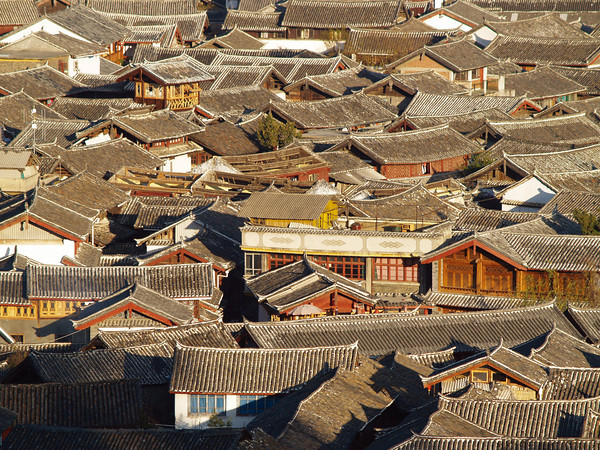When reading Orville Schell’s recent article in Conde Nast Traveler, “China’s Magic Melting Mountain,” readers might notice that the destinations in Yunnan he describes seem rather, well, touristy.
Schell is quick to outline the realities of these tourist meccas. Of Mt. Kawagebo, he writes:
“A distant rooster crows, and the sun bursts into full flame over the ridge. As if some switch were thrown to make them artificially glow from within, the mountains’ peaks become tinted with gold and orange. The Chinese tourists around me begin clicking away on their cameras with the intensity of tail gunners whose bomber squadron has suddenly come under attack.”
On Lijiang, Schell is even less forgiving; he calls it a “high-kitsch carnival of Naxi minority culture.”

Lijiang: unforgettable Naxi minority town, or simply a playground for mass tourism?
Comments such as these beg the question: if Yunnan’s Lijiang and Mt. Kawagebo are so kitschy and crowded, then what is the point of visiting them? And, from a potential client’s point of view, why is AsiaTravel still visiting these areas? Don’t they promote “experiencing China differently?”
We, too, have often debated the issue of historical and culture value versus tourist developments and influx in these areas. In the spring and summer of 2009, we wrote a few blog posts on the issue. Our April 14, 2009 blog post, entitled “What We’re Reading: NYTimes Goes to Yunnan,” addresses the struggles of preserving the uniqueness of such a popular destination on our trips:
“For operators like AsiaTravel, it’s always a balancing act to manage sustainable development of a site while promoting its appeal to future travelers. On one hand, you might want to keep small places a secret so that they retain that je ne sais quo that made the place so appealing in the first place. On the other, you want to promote these amazing places and tell everyone about them so that they can share your experience.”
Three days later, we explained our philosophy regarding responsible tourism:
“For AsiaTravel, our goal of responsible travel includes providing travelers a greater understanding of local cultural and environmental issues… It means visiting Songzanlin Monastery, also referred to by Jenkins, but having monks guide us through areas normally off-limits and having tea with a top lama in his private chambers. And it means visiting local families in surrounding Tibetan villages, like Hamagu, where World Wildlife Fund (WWF) is working to build support for sustainable tourism as an alternative source of income to logging.”
We at AsiaTravel realize that as more tourists flood these areas, some aspects of local culture and environment are inevitably compromised. However, despite these realities, we strongly believe that we are still able to give our guests a unique travel and cultural experience.
How do we accomplish this? We travel away from the crowds. We engage in people-to-people meetings and interactions so that our travelers experience daily Chinese life. We offer once-in-a-lifetime opportunities, such as meeting with a Bimo shaman (see our Chinese Treasures itinerary). In smaller, more intimate Naxi villages nearby, we take our guests to local markets and community performances by village elders. It is through these personalized experiences and intimate looks at life in Yunnan that we are able to customize our travelers’ experiences and maintain the wonder of local cultures for our guests.
It’s also important to consider why these sites have become as touristic as they are. Why do thousands flock to Yunnan each year? There is clearly a reason why: Yunnan is one of the most diverse areas of China. Lijiang is a UNESCO World Heritage Site and an absolute must-see; Mt. Kawagebo is a spectacular and breathtaking sacred Tibetan mountain. While we cannot and do not deny that mass tourism does have negative effects upon these areas, the tourist culture in this area reflects the reality of Chinese domestic travel, and, for the reasons mentioned above, is justified.
Orville Schell does not sugarcoat his opinions of Lijiang, Mt. Kawagebo, and the current tourist climate in China. But he is still writing about them. Why? Because regardless of the tourists visiting these sites, they are still simply remarkable.
———–
We invite you to join us in our ongoing rethinking of tourism in China. If you have something to say about this topic, please leave a comment, or email Alex at alex.grieves@wildchina.com. We’d love to hear from you.
